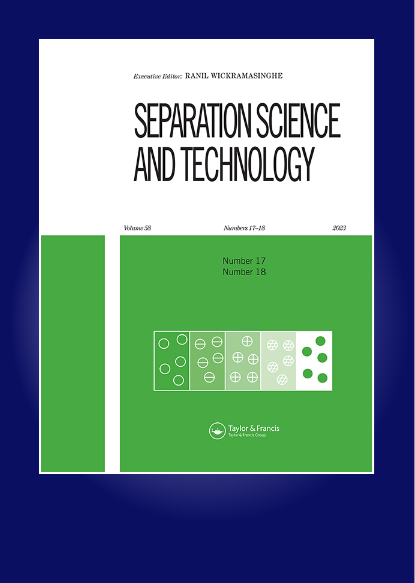Selective extraction of molybdenum (VI) with novel ionic liquid from nitric acid solution
IF 2.3
4区 工程技术
Q3 CHEMISTRY, MULTIDISCIPLINARY
引用次数: 0
Abstract
ABSTRACT The novel ionic liquid [Aliq–336]+[HCit]− is produced by the reaction of tricaprylylmethyl ammonium chloride, Aliq–336, and tri-sodium citrate. In this investigation, the extraction of Mo(VI) from the nitric acid solution using ([Aliq-336]+[HCit]−) ionic liquid in toluene as a diluent was studied. The effects of various parameters on the extraction process such as shaking time, nitric acid concentration, ionic liquid concentration, hydrogen ion, nitrate ion, Mo(VI) concentration as well as temperature were evaluated. The loading capacity of the prepared ionic liquid was 0.078 mole of Mo(VI) per mole [Aliq-336]+[HCit]−. On the basis of IR spectra and the slope analysis method, the installation of the expected extracted metal species in the organic phase was found to be . As well, the average conditional extraction constant (KCex) for Mo(VI) extraction was 45.96 ± 3.5. The stripping percent of Mo(VI) reached the maximum value (exceeding 99.0%) with 0.5 mol/L sodium acetate as well as 1.0 mol/L of different mineral acids. Based on the obtained results, the prepared ionic liquid in toluene could be used for the effective extraction of molybdenum (VI) from a synthetic mixture of different metal ions found in fission products.新型离子液体从硝酸溶液中选择性萃取钼(VI)
摘要:新型离子液体[Aliq-336]+[HCit]−由三丙基甲基氯化铵、Aliq-336和柠檬酸三钠反应生成。本文研究了以甲苯为稀释剂,用([Aliq-336]+[HCit]−)离子液体从硝酸溶液中萃取Mo(VI)。考察了振荡时间、硝酸浓度、离子液体浓度、氢离子、硝酸盐离子、Mo(VI)浓度、温度等参数对提取过程的影响。离子液体的负载量为0.078 mol / mol [Aliq-336]+[HCit]−。根据红外光谱和斜率分析方法,发现期望提取的金属在有机相中的安装位置为。Mo(VI)提取的平均条件提取常数(KCex)为45.96±3.5。在0.5 mol/L乙酸钠和1.0 mol/L不同无机酸的条件下,Mo(VI)的溶出率达到最大值(99.0%以上)。根据所得结果,所制备的甲苯离子液体可用于从裂变产物中不同金属离子的合成混合物中有效提取钼(VI)。
本文章由计算机程序翻译,如有差异,请以英文原文为准。
求助全文
约1分钟内获得全文
求助全文
来源期刊

Separation Science and Technology
工程技术-工程:化工
CiteScore
6.10
自引率
3.60%
发文量
131
审稿时长
5.7 months
期刊介绍:
This international journal deals with fundamental and applied aspects of separation processes related to a number of fields. A wide range of topics are covered in the journal including adsorption, membranes, extraction, distillation, absorption, centrifugation, crystallization, precipitation, reactive separations, hybrid processes, continuous separations, carbon capture, flocculation and magnetic separations. The journal focuses on state of the art preparative separations and theoretical contributions to the field of separation science. Applications include environmental, energy, water, and biotechnology. The journal does not publish analytical separation papers unless they contain new fundamental contributions to the field of separation science.
 求助内容:
求助内容: 应助结果提醒方式:
应助结果提醒方式:


